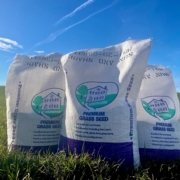Planting the Perfect Lawn
There’s no better way to spruce up your spring landscaping and get ready for that first BBQ of summer than by planting a new lawn.
And as the grass seed capital of the world, Oregon produces major cool season grasses such as Tall Fescue, Fine Fescue, Ryegrass, Bentgrass, and Kentucky Bluegrass. And you guessed it, these grasses are local to Oregon, and the best for our cool climate!
In addition to providing a wonderful place to gather, for your kids to play, and for recreational activities, your yard offers environmental benefits, including:
- Erosion Control
- Cooling
- Carbon Capture
- Improve Water Quality
Sometimes this can be an overwhelming task to take on, but with a few tips and a good plan, planting a lawn can be a fun and rewarding project.
- WHEN TO PLANT
The first thing to consider when planting a new lawn is temperature of both the air and soil. Grass seed germinates best when the air temperature is between 60- and 85-degrees Fahrenheit. This also allows the soil to warm up and for those brand-new roots to thrive. Plan to plant your seed when the air temperature will likely stay in this range for six-to-eight weeks.
- PREPARING THE SEED BED
When preparing your seed bed, consider the existing soil type. Is the soil you’re planning to plant into the native soil, or is it fill brought in after construction of a new home? Most soils in the Pacific Northwest have adequate fertility for a strong and healthy lawn, but in some cases, it may be necessary to bring in topsoil, if fill dirt was brought in for new construction for example. You may consider having your soil tested to determine the pH level and decide if adding lime before planting is necessary. Most turf grasses do well in pH levels of 5.5 to 6.5.
- PREPARING THE SOIL
Preparing the soil comes next. This is done to loosen the soil and to make it easier to grade and level. If your yard is rough, you may consider rototilling to prepare the seed bed. Avoid tilling when the soil is wet as it can damage soil structure and create large clods. If you are adding lime, make sure to incorporate it in to ensure it is mixed well with your soil. Rake and roll the seedbed to achieve a nice and smooth surface – no one likes running barefoot on a bumpy lawn!
- WHAT ABOUT EXISTING LAWNS?
If you are renovating an existing lawn, or your former lawn was smooth, there are some other options to consider. Perhaps your existing lawn is just needing a spruce up. If you have some good existing grass you would like to keep, using a de-thatcher may be a good option. A de-thatcher can also create a nice seed bed for complete lawn renovation by going over the ground in several different directors. These tools are available to rent locally and cut vertically through the existing turf and into the soil at a shallow depth. The creates a fine soil condition that is perfect for good seed germination. This method will create a large amount of thatch that will need to be raked up and hauled away. After the thatch is removed, the loose soil can be raked, rolled, then grass seed can be spread.
- DECIDING WHAT TO PLANT
The biggest decision you’ll likely have to make when planting a new lawn is deciding what kind of grass to use. In the pacific northwest, there are three main turf grass types to choose from: Perennial Ryegrass, Tall Fescue, and Fine Fescue.
- Perennial Ryegrass is the most common turf grass planted. It has a beautiful green color and is soft on your kiddo’s bare feet in the summer. This turf grass does best in full sun and requires consistent watering to keep green as its roots are shallow. If you choose Perennial Ryegrass, be sure to plan a fertilization schedule. Plant eight-to-10 pounds of Perennial Ryegrass seed per 1,000 square feet.
- Tall Fescue is often used for lawns in the pacific northwest as well. While it has thicker, slightly stiffer grass blades, it offers benefits of increased drought tolerance, and is known to withstand more wear and tear from kids, lawn games, and mowers. It grows well in sun or shade and newer varieties have a nice, dark green color. Plant eight-to-10 pounds of tall fescue seed per 1,000 square feet.
- Fine Fescue, which comes in three types: Creeping Red Fescue, Chewings Fescue, and Hard Fescue, offers a good blend of softer bladed grass, with the higher wear and tear tolerance and drought tolerance of Tall Fescue. This grass is a good choice for soil with lower fertility and/or shared areas. Fine Fescue is typically used in a mix with the Perennial Ryegrass and/or Tall Fescue. Planted alone as a lawn, the seed rate for Fine Fescue is five-to-seven pounds per 1,000 square feet.
- PLANTING
Once you have decided on the turf seed type or mix, it’s time to plant.
Use a seed dropper to spread seed and follow with a roller to ensure good soil to seed contact. You may choose to do an application of mulch or peat moss on top of the seed to hold moisture and help aid germination, and possibly help with erosion if your lawn is sloped. Make sure to spread your mulch or peat no thicker than 1/8 – 1/4 inch thick.
When making an irrigation plan, you want to keep the seed moist so it will germinate, but not soggy and waterlogged, as this could cause rot issues. Ideally, the area should be watered two-to-four times daily, just long enough for the surface to look wet. Do this until you see that the majority of the seed has germinated, and that green covers the entire area.
Don’t count on spring rains to do this for you. You’ll need to keep a watchful eye for the first week or so after you plant your seed. Once the grass is up and growing, slowly transition to longer, more infrequent waterings.
- FERTILIZER
Lastly, it’s time for fertilizer. For seeded lawns, you can use nearly any fertilizer that is relatively high in nitrogen. Nitrogen can either alone or in combination with Phosphorus or Potassium stimulates growth after germination and speeds establishment on the turf. In most situations for seeded lawns, try the following approach:
- Apply a complete fertilizer (Nitrogen-Phosphorus-Potassium) when you plant at a rate of 1.5-to-two pounds Nitrogen per 1,000 square feet. You can use 15-15- 15 if you’d like, but regular turf-grade fertilizers high in nitrogen and potassium and low in phosphorus (e.g., 10-2-6, 21-7-14, 24-4-12, etc.) are best.
- Reapply at the same rate about four-to-six weeks after planting to further accelerate establishment. These will be the two most important applications you will ever make to your lawn.
- MAINTAIN YOUR LAWN
Start to mow as soon as there is enough grass to cut, water, and control the weeds.
- ENJOY
Enjoy the endless benefits to a beautiful lawn – and not just aesthetics.
Know that your lawn is helping the environment as a regenerative resource, it controls erosion; offers cooling; captures carbon; and can improve water quality acting as a natural filter.
Contributed by: The Ioka Farms/Marketing Team and The Oregon Seed Council. Sources: “Practical Lawn Establishment and Renovation” by Tom Cook, Oregon State University, 2004.
If you have any questions on the benefits of Oregon grown seed, please contact the Oregon Seed Council at info@oregonseedcouncil.org or visit our website at OregonSeedCouncil.org.


